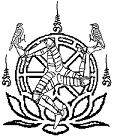This is the main form of Mettā Bhāvanā I engage in.
Instructions
- Settle into a comfortable & erect posture.
- Bring your awareness to the body, focusing your attention on the sensations of touch and pressure in your body where it makes contact with the floor and any support you are using. Spend a few moments exploring these sensations, and then direct your attention to the posture, paying attention for any tension being caused by poor posture, and uneven balance, straightening and adjusting the posture to ease any discomfort.
- Now bring your awareness to the breath coming in and out of the body at the point where a sensation of breathing is most prominent - be it a sensation within the nasal passages, or the lips & mouth, chest, & abdomen movements, or anywhere else. As the breath moves in and out of your body, take several deep breaths to get fully acquainted with the sensation before allowing your breath to relax into its natural flow, allowing what is to be, especially noticing how the breath is, whether short & shallow; or long & deep.
If there is any discomfort or strain with the breathing this may show a unconscious controlling influence on the breath, so if it persists, breath deeply a few times again and experiment with the breathing to find a rhythm the body is comfortable with before once again relaxing into the breath - Move your attention to the other areas where the breath can be observed - be it within the nasal passages, or the lips & mouth, chest, abdomen, or anywhere else - to know the different sensations of the breath within the body. Focus your awareness on the movement of the body during the slight stretching as the abdomen or chest expands with each inhalation, and of gentle deflation as it falls with each Exhalation, or the coolness of the touch sensation at the nasal passages, or lips & mouth on the inhalation and warmth of the exhalation, as best you can, taking several deep breaths to get fully acquainted with the sensations before allowing your breath to relax into its natural flow. Again noticing how the breath is, whether short & shallow; or long & deep, as-well as the slight pauses between the inhalation and exhalation, and between the exhalation and inhalation.
- Once you are familiar with the breath at different prominent areas, bring your focus to the sensations at the nasal passage or lips & mouth continuing to follow the breaths natural rhythm while observing the flow of the breath through the body from the beginning of the inhalation to the end of the exhalation.
- At some point the mind will stray away from its focus on the breath to thoughts, moods, planning, daydreams, or simply drifting along with the sensations in a state similar to sleep. This is just what the mind does daily, simply following its normal routine of trying to find pleasure, not that you are doing anything wrong or proof one can not meditate. When you notice that your focus has not been on the breath this is being clearly aware & a sign of engaging in the practice of being fully aware of the present moment! You should know what state the mind has been in & bring the focus back to the breath. No-matter how often you notice the mind wandering off, simply keep bringing it back to the object.
- As best you can, bring qualities of friendliness, joy, care, & balance to your awareness, perhaps seeing the repeated wanderings of the mind as opportunities to develop patience, effort, and curiosity to what is going on.
- While focusing upon the breath spend a some time relaxing the subtle movements the body naturally performs, from breathing itself to any twitching, itches, or aches & pains, scanning where these tensions are, relaxing the area and exploring it fully with curiosity, mentally say “calm,” “relax,” or another calming word to strengthen the intention to calm the area, and maybe imagining the breath going through this area healing and dissipating the tension. Once you have observed the area review previous places where there was tension and see if there has developed any residue tension in the general location.
- Having established a sense of calm use this to first develop qualities of goodwill by reflecting on specific aspect using the mnemonic device P.U.F.F. which means -
- Slowly repeat each word mentally and reflect on what this aspect of Metta has. As you reflect like this try to notice each quality within yourself, either be it a recollection of a time this quality was prominent, or by its presence in your awareness.
- As each quality comes to your awareness, nurture, and develop them. Notice how the body reacts to these qualities.
- Patience,
- Understanding,
- Friendliness, and
- Forgiveness.
Notes
For my understanding of these qualities please see "A Puff Of Metta".
Other mnemonic devices you may like to use could be
Metta
meditation
enlightenment
thought
tranquillity
awareness
Chocolate
compassion
happiness
oneness
cooperation
others
love
awareness
tenderness
empathy
Peace
Patience
Empathy
Altruism
Compassion
Enlightenment
Other mnemonic devices you may like to use could be
Metta
meditation
enlightenment
thought
tranquillity
awareness
Chocolate
compassion
happiness
oneness
cooperation
others
love
awareness
tenderness
empathy
Peace
Patience
Empathy
Altruism
Compassion
Enlightenment

 RSS Feed
RSS Feed
